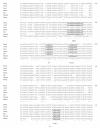Analysis of horse myostatin gene and identification of single nucleotide polymorphisms in breeds of different morphological types
- PMID: 20706663
- PMCID: PMC2913906
- DOI: 10.1155/2010/542945
Analysis of horse myostatin gene and identification of single nucleotide polymorphisms in breeds of different morphological types
Abstract
Myostatin (MSTN) is a negative modulator of muscle mass. We characterized the horse (Equus caballus) MSTN gene and identified and analysed single nucleotide polymorphisms (SNPs) in breeds of different morphological types. Sequencing of coding, untranslated, intronic, and regulatory regions of MSTN gene in 12 horses from 10 breeds revealed seven SNPs: two in the promoter, four in intron 1, and one in intron 2. The SNPs of the promoter (GQ183900:g.26T>C and GQ183900:g.156T>C, the latter located within a conserved TATA-box like motif) were screened in 396 horses from 16 breeds. The g.26C and the g.156C alleles presented higher frequency in heavy (brachymorphic type) than in light breeds (dolichomorphic type such as Italian Trotter breed). The significant difference of allele frequencies for the SNPs at the promoter and analysis of molecular variance (AMOVA) on haplotypes indicates that these polymorphisms could be associated with variability of morphology traits in horse breeds.
Figures




Similar articles
-
Single nucleotide polymorphisms of myostatin gene in Chinese domestic horses.Gene. 2014 Mar 15;538(1):150-4. doi: 10.1016/j.gene.2013.12.027. Epub 2013 Dec 22. Gene. 2014. PMID: 24368331
-
Analysis of the 227 bp short interspersed nuclear element (SINE) insertion of the promoter of the myostatin (MSTN) gene in different horse breeds.Vet Ital. 2014 Jul-Sep;50(3):193-7. doi: 10.12834/VetIt.61.178.3. Vet Ital. 2014. PMID: 25273961
-
Characterization of Partial Sequence of Myostatin Gene Exon 2 along with SNP detection in Indian Horse Breeds (Equus caballus).J Equine Vet Sci. 2022 Sep;116:104047. doi: 10.1016/j.jevs.2022.104047. Epub 2022 Jun 16. J Equine Vet Sci. 2022. PMID: 35716837
-
SNP identification and polymorphism analysis in exon 2 of the horse myostatin gene.Anim Genet. 2012 Apr;43(2):229-32. doi: 10.1111/j.1365-2052.2011.02229.x. Epub 2011 Jul 22. Anim Genet. 2012. PMID: 22404361
-
Identification of a new haplotype within the promoter region of the MSTN gene in horses from five of the most common breeds in Poland.Folia Biol (Krakow). 2014;62(3):219-22. doi: 10.3409/fb62_3.219. Folia Biol (Krakow). 2014. PMID: 25403076
Cited by
-
Genome-wide analysis reveals selection for important traits in domestic horse breeds.PLoS Genet. 2013;9(1):e1003211. doi: 10.1371/journal.pgen.1003211. Epub 2013 Jan 17. PLoS Genet. 2013. PMID: 23349635 Free PMC article.
-
Comprehensive genome and transcriptome analyses reveal genetic relationship, selection signature, and transcriptome landscape of small-sized Korean native Jeju horse.Sci Rep. 2019 Nov 13;9(1):16672. doi: 10.1038/s41598-019-53102-8. Sci Rep. 2019. PMID: 31723199 Free PMC article.
-
Functional replacement of myostatin with GDF-11 in the germline of mice.Skelet Muscle. 2022 Mar 15;12(1):7. doi: 10.1186/s13395-022-00290-z. Skelet Muscle. 2022. PMID: 35287700 Free PMC article.
-
Effect of selection for eventing on the MSTN gene in Brazilian sport horses.J Equine Sci. 2018;29(1):21-24. doi: 10.1294/jes.29.21. Epub 2018 Mar 23. J Equine Sci. 2018. PMID: 29593445 Free PMC article.
-
A genome-wide association study for harness racing success in the Norwegian-Swedish coldblooded trotter reveals genes for learning and energy metabolism.BMC Genet. 2018 Aug 29;19(1):80. doi: 10.1186/s12863-018-0670-3. BMC Genet. 2018. PMID: 30157760 Free PMC article.
References
-
- McPherron AC, Lawler AM, Lee S-J. Regulation of skeletal muscle mass in mice by a new TGF-β superfamily member. Nature. 1997;387(6628):83–90. - PubMed
-
- Joulia-Ekaza D, Cabello G. Myostatin regulation of muscle development: molecular basis, natural mutations, physiopathological aspects. Experimental Cell Research. 2006;312(13):2401–2414. - PubMed
-
- Stratil A, Kopecny M. Genomic organization, sequence and polymorphism of the porcine myostatin (GDF8; MSTN) gene. Animal Genetics. 1999;30(6):468–469. - PubMed
Publication types
MeSH terms
Substances
LinkOut - more resources
Full Text Sources
Miscellaneous

